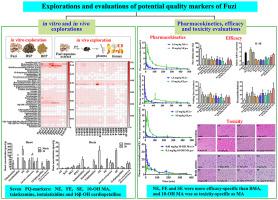Journal of Ethnopharmacology ( IF 4.8 ) Pub Date : 2022-11-10 , DOI: 10.1016/j.jep.2022.115879 Xiaocui Li 1 , Weiqing Hou 1 , Tingting Lin 1 , Jiadong Ni 1 , Huawei Qiu 1 , Yu Fu 1 , Zhongxiang Zhao 1 , Caihua Yang 2 , Na Li 3 , Hua Zhou 4 , Rong Zhang 1 , Zhongqiu Liu 1 , Ling Fu 5 , Lijun Zhu 1

|
Ethnopharmacological relevance
Fuzi, the lateral roots of Aconitum carmichaelii Debx, plays an irreplaceable role in treating Yang deficiency and cold coagulation syndromes. However, Fuzi has a narrow margin of safety since its pharmacological constituents, Aconitum alkaloids, have potential cardiotoxicity and neurotoxicity. The current quality markers (Q-markers) for the control of Fuzi's efficacy and toxicity are 3 monoester-diterpenoid alkaloids, namely, benzoylaconine (BAC), benzoylhypaconine and benzoylmesaconine (BMA) and 3 diester-diterpenoid alkaloids, namely, aconitine (AC), hypaconitine and mesaconitine (MA). However, mounting evidence indicates that the current 6 Q-markers may not be efficacy- or toxicity-specific enough for Fuzi.
Aim of the study
The aim of this study was to explore and evaluate efficacy- or toxicity-specific potential quality markers (PQ-markers) of Fuzi.
Materials and methods
PQ-markers were explored by analyzing 30 medicinal samples and alkaloids exposed in mouse. Pharmacokinetics of PQ-markers on C57BL/6J mice were determined. Anti-inflammatory effects of PQ-markers were evaluated by λ-carrageenan-induced paw edema model and lipopolysaccharide-induced RAW264.7 cell inflammatory model, while analgesic effects were assessed by acetic acid-induced pain model and Hargreaves test. Cardiotoxicity and neurotoxicity of PQ-markers were assessed by histological and biochemical analyses, while acute toxicity was evaluated by modified Kirschner method.
Results
After in vitro and in vivo explorations, 7 PQ-markers, namely, neoline (NE), fuziline (FE), songorine (SE), 10-OH mesaconitine (10-OH MA), talatizamine, isotalatizidine and 16β-OH cardiopetalline, were found. In the herbal medicines, NE, FE, SE and 10-OH MA were found in greater abundance than many other alkaloids. Specifically, the amounts of NE, FE and SE in the Fuzi samples were all far higher than that of BAC, and the contents of 10-OH MA in 56.67% of the samples were higher than that of AC. In mouse plasma and tissues, NE, FE, SE, talatizamine, isotalatizidine and 16β-OH cardiopetalline had higher contents than the other alkaloids, including the 6 current Q-markers. The pharmacokinetics, efficacy and toxicity of NE, FE, SE and 10-OH MA were further evaluated. The average oral bioavailabilities of NE (63.82%), FE (18.14%) and SE (49.51%) were higher than that of BMA (3.05%). Additionally, NE, FE and SE produced dose-dependent anti-inflammatory and analgesic effects, and their actions were greater than those of BMA. Concurrently, the toxicities of NE, FE and SE were lower than those of BMA, since no cardiotoxicity or neurotoxicity was found in mice after NE, FE and SE treatment, while BMA treatment notably increased the creatine kinase activity and matrix metalloproteinase 9 level in mice. The average oral bioavailability of 10-OH MA (7.02%) was higher than that of MA (1.88%). The median lethal dose (LD50) of 10-OH MA in mice (0.11 mg/kg) after intravenous injection was close to that of MA (0.13 mg/kg). Moreover, 10-OH MA produced significant cardiotoxicity and neurotoxicity, and notable anti-inflammatory and analgesic effects that were comparable to those of MA.
Conclusions
Seven PQ-markers of Fuzi were found after in vitro and in vivo explorations. Among them, NE, FE and SE were found to be more efficacy-specific than BMA, and 10-OH MA was as toxicity-specific as MA.
中文翻译:

Neoline、fuziline、songorine 和 10-OH mesaconitine 是附子的潜在质量标志物:体外和体内探索以及药代动力学、疗效和毒性评价
民族药理学相关性
附子是乌头的侧根,在治疗阳虚寒凝证方面具有不可替代的作用。然而,由于附子的药理成分乌头生物碱具有潜在的心脏毒性和神经毒性,因此其安全范围很窄。目前用于控制附子药效和毒性的质量标志物(Q-markers)是3种单酯二萜生物碱,即苯甲酰乌头碱(BAC)、苯甲酰次乌头碱和苯甲酰中乌头碱(BMA)和3种双酯二萜生物碱,即乌头碱(AC) 、次乌头碱和新乌头碱 (MA)。然而,越来越多的证据表明,目前的 6 个 Q 标记可能对附子的功效或毒性不够特异性。
研究目的
本研究的目的是探索和评估附子的功效或毒性特异性潜在质量标志物(PQ 标志物)。
材料和方法
通过分析暴露在小鼠体内的 30 种药用样品和生物碱来探索 PQ 标记。确定了 C57BL/6J 小鼠上 PQ 标志物的药代动力学。通过λ-角叉菜胶诱导的爪水肿模型和脂多糖诱导的RAW264.7细胞炎症模型评估PQ标志物的抗炎作用,而通过乙酸诱导的疼痛模型和Hargreaves试验评估镇痛作用。PQ 标志物的心脏毒性和神经毒性通过组织学和生化分析进行评估,而急性毒性则通过改良克氏法进行评估。
结果
经过体外和体内探索发现了 7 种 PQ 标记物,即 neoline (NE)、fuziline (FE)、songorine (SE)、10-OH mesaconitine (10-OH MA)、talatizamine、isotalatizidine 和 16β-OH cardiopetalline。在草药中,NE、FE、SE 和 10-OH MA 的含量高于许多其他生物碱。具体而言,附子样品中NE、FE、SE含量均远高于BAC,56.67%的样品中10-OH MA含量高于AC。在小鼠血浆和组织中,NE、FE、SE、talatizamine、isotalatizidine和16β-OH cardiopetalline的含量高于其他生物碱,包括目前的6种Q-markers。进一步评价NE、FE、SE和10-OH MA的药代动力学、疗效和毒性。NE(63.82%)、FE(18.14%)和SE(49.51%)的平均口服生物利用度高于BMA(3. 05%)。此外,NE、FE 和 SE 产生剂量依赖性抗炎和镇痛作用,并且它们的作用大于 BMA。同时,NE、FE 和 SE 的毒性低于 BMA,因为在 NE、FE 和 SE 处理后小鼠中未发现心脏毒性或神经毒性,而 BMA 处理显着增加了小鼠的肌酸激酶活性和基质金属蛋白酶 9 水平. 10-OH MA 的平均口服生物利用度 (7.02%) 高于 MA (1.88%)。半数致死剂量(LD 而 BMA 治疗显着增加了小鼠的肌酸激酶活性和基质金属蛋白酶 9 水平。10-OH MA 的平均口服生物利用度 (7.02%) 高于 MA (1.88%)。半数致死剂量(LD 而 BMA 治疗显着增加了小鼠的肌酸激酶活性和基质金属蛋白酶 9 水平。10-OH MA 的平均口服生物利用度 (7.02%) 高于 MA (1.88%)。半数致死剂量(LD50 ) 10-OH MA 在小鼠体内的静脉注射后 (0.11 mg/kg) 与 MA (0.13 mg/kg) 接近。此外,10-OH MA 产生显着的心脏毒性和神经毒性,以及与 MA 相当的显着抗炎和镇痛作用。
结论
经过体外和体内探索,发现了七种附子的PQ-标记。其中,NE、FE 和 SE 被发现比 BMA 更具疗效特异性,而 10-OH MA 与 MA 一样具有毒性特异性。






























 京公网安备 11010802027423号
京公网安备 11010802027423号